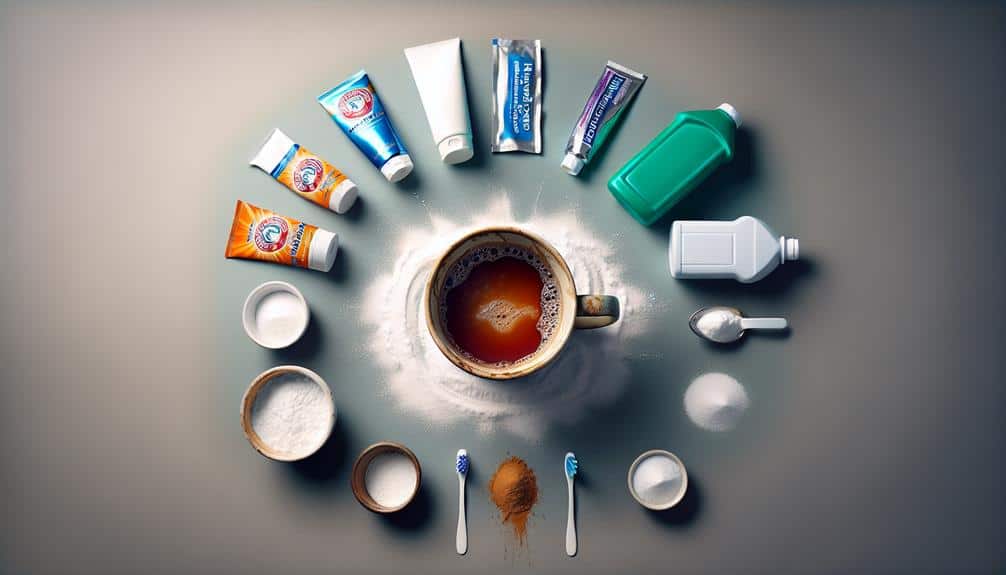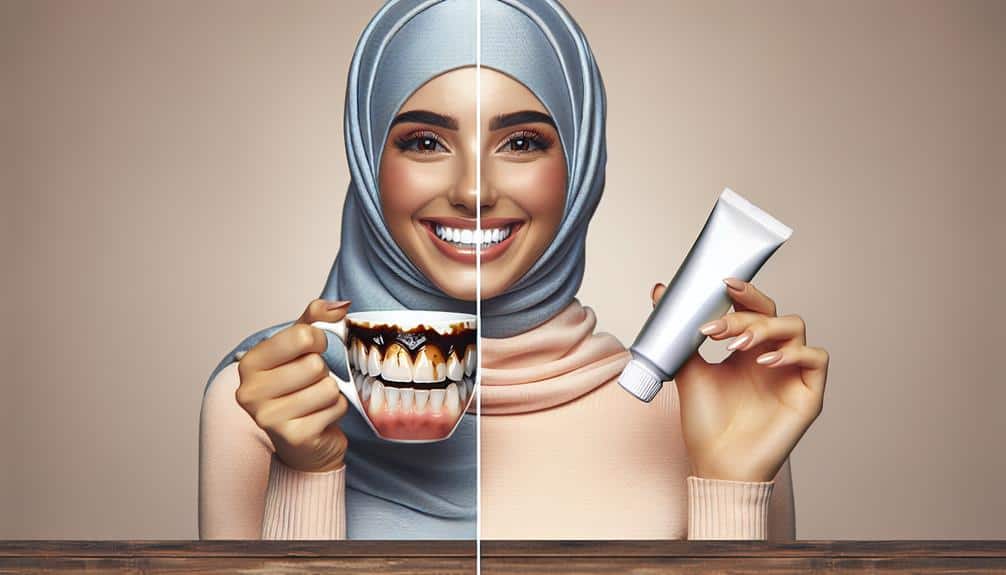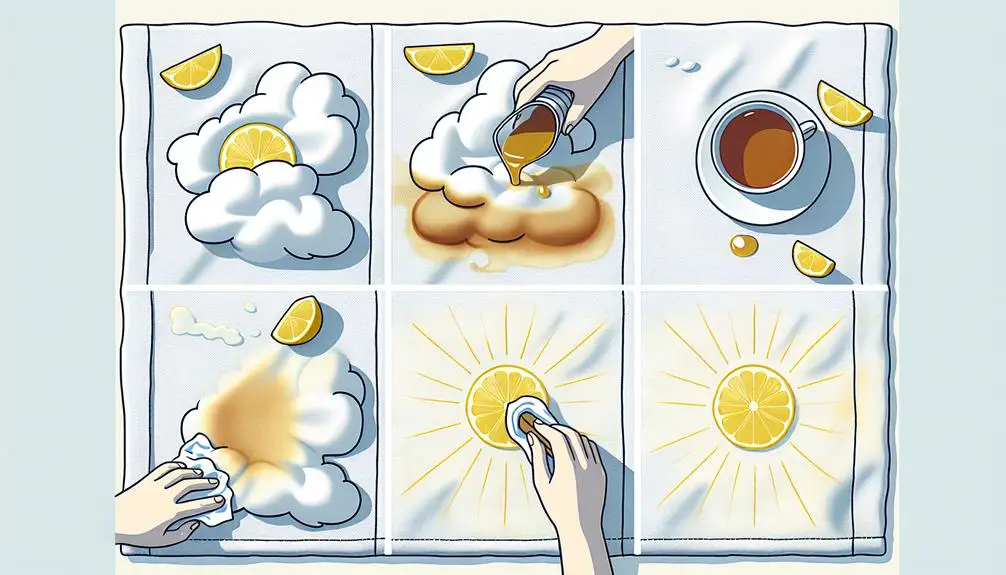Over-the-counter products whiten tea stains by using key ingredients to penetrate enamel and break down deep-seated discoloration effectively. Ingredients like hydrogen peroxide, carbamide peroxide, and baking soda play vital roles in this process. These products are designed to safeguard enamel while removing stains, offering gradual improvement with consistent use. Guarantee safety by checking for allergens, following usage guidelines, and consulting a dentist for underlying conditions. Applying whitening toothpaste with fluoride further aids in enamel protection. Safely using these products can enhance your oral health and whiten your teeth effectively.
Key Points
- Active ingredients like hydrogen peroxide penetrate enamel to break down tea stains effectively.
- Chemical reactions in OTC products target and remove deep-set stains on teeth.
- Over-the-counter products are designed to protect enamel while whitening teeth.
- Ingredients like carbamide peroxide break down into whitening agents for enhanced effects.
- Consistent use of OTC products leads to gradual improvement in teeth whiteness.
Tea Stains and Whitening Basics
Tea stains on your teeth can be stubborn to remove, requiring an understanding of the whitening basics to effectively tackle them. When it comes to tea stain removal, natural remedies can be a crucial yet effective way to combat discoloration without harsh chemicals.
One popular method is using baking soda, which has mild abrasive properties that can help scrub away surface stains. Mixing a small amount of baking soda with water to create a paste and brushing your teeth with it can gradually reduce the appearance of tea stains over time.
Another natural remedy for tea stain removal is hydrogen peroxide. This compound is often used in whitening toothpaste for its ability to break down stains and lighten the color of teeth. Creating a mouthwash by diluting hydrogen peroxide with water can be an efficient way to target tea stains specifically. However, employing these remedies in moderation is crucial to avoid damaging the enamel of your teeth.
Incorporating these natural remedies into your oral care routine can aid in effectively removing tea stains and restoring a brighter smile.
How Over-The-Counter Products Work
To understand how over-the-counter products work in whitening tea stains, consider the mechanisms behind these products and their effectiveness in targeting specific types of discoloration on teeth. Over-the-counter whitening products leverage chemical reactions to break down and remove stains from the surface of teeth.
Here are the key points to grasp:
- Chemical Reactions: These products contain active ingredients that initiate chemical reactions with the stains on your teeth, helping to dissolve and remove them effectively.
- Stain Penetration: The formulation of over-the-counter products allows them to penetrate the enamel and target deep-set stains that may not be easily removed by regular brushing.
- Enamel Protection: While removing stains, these products are designed to safeguard the enamel of your teeth, ensuring that the whitening process doesn't compromise the integrity of your dental structure.
- Targeted Action: By specifically targeting stains, over-the-counter products can focus on discolored areas, providing a more precise and efficient whitening process.
- Gradual Improvement: Consistent use of these products over time can lead to gradual but noticeable improvements in the whiteness of your teeth, enhancing your overall smile.
Common Ingredients in Whitening Products
Common whitening products contain various active ingredients that play an important role in the effectiveness of the whitening process on teeth. When selecting a whitening product, understanding the key ingredients and their effectiveness is vital.
Commonly used active ingredients in whitening products include hydrogen peroxide, carbamide peroxide, and baking soda. Hydrogen peroxide is a potent bleaching agent that can penetrate the enamel to break down stains effectively. Carbamide peroxide, a popular alternative, breaks down into hydrogen peroxide and urea, enhancing its whitening capabilities. Baking soda, recognized for its gentle abrasiveness, helps scrub away surface stains on the teeth.
When considering whitening product options, it's crucial to opt for those with clinically proven active ingredients to guarantee effectiveness. Different products may contain varying concentrations of these ingredients, impacting their whitening potency. Understanding the role of these active ingredients can help you make an informed decision when choosing a whitening product that aligns with your needs and preferences.
Effectiveness and Safety Considerations
Considering the effectiveness and safety of whitening products is essential when aiming to achieve a brighter smile with confidence. When using over-the-counter (OTC) products to whiten tea stains, it's vital to understand the safety precautions and potential risks involved.
Here are some key points to keep in mind:
- Ingredients: Check the ingredients list for any known allergens or harsh chemicals that may cause sensitivity or adverse reactions.
- Instructions: Follow the manufacturer's directions carefully to guarantee excellent results without damaging your teeth or gums.
- Consultation: If you have any underlying dental conditions or concerns, consult with your dentist before using OTC whitening products.
- Duration: Don't exceed the recommended period of use as prolonged exposure to whitening agents can lead to tooth sensitivity or enamel damage.
- Monitoring: Keep track of any changes in your oral health during and after using whitening products to promptly address any issues that may arise.
Tips for Using OTC Products Safely
When using OTC whitening products to address tea stains, prioritize safety by carefully following usage guidelines and monitoring any changes in your oral health. Key usage of OTC products is vital to achieve effective results while minimizing potential risks.
Always adhere to the recommended application techniques provided by the product manufacturer. It's imperative to apply the whitening products as instructed to prevent adverse effects on your teeth and gums.
Additionally, consider precautionary measures such as using a whitening toothpaste with fluoride to protect your enamel and consulting with a dentist before starting any whitening treatment.
Monitor your oral health during the whitening process and discontinue use if you experience any sensitivity or irritation. By practicing safe application techniques and taking necessary precautions, you can effectively remove tea stains from your teeth without compromising your oral health.
Frequently Asked Questions
Can Over-The-Counter Whitening Products Be Used on Other Types of Stains Besides Tea Stains?
When it comes to stain removal, over-the-counter whitening products can work wonders on various types of stains, not just tea stains. From clothing to countertops, these products offer effective surface cleaning for a range of stubborn stains.
Are There Any Potential Side Effects or Risks Associated With Using Over-The-Counter Whitening Products on Teeth?
When using over-the-counter whitening products on teeth, potential risks like gum irritation or tooth sensitivity may occur. However, if used correctly, these products are generally safe and effective in providing noticeable results for whitening teeth.
How Often Should Over-The-Counter Whitening Products Be Used to See Noticeable Results on Tea Stains?
For best results on tea stains, use over-the-counter whitening products as directed, typically a few times a week. Consistent use is key, as overdoing it can lead to sensitivity and other long-term effects on your teeth.
Are There Any Natural Alternatives to Over-The-Counter Whitening Products for Removing Tea Stains?
When it comes to removing tea stains, exploring natural alternatives like DIY solutions or herbal remedies can be effective. Not only are these options gentle on your teeth, but they can also provide a more sustainable approach to oral care.
Can Over-The-Counter Whitening Products Be Used on All Types of Tea Stains, Including Older, Set-In Stains?
To effectively remove tea stains, over-the-counter whitening products work on various types of stains, including older ones. They provide immediate results, but long-term maintenance is necessary for sustained whiteness. Regular use guarantees effectiveness in tackling stubborn tea stains.



